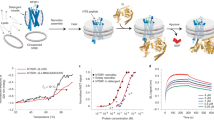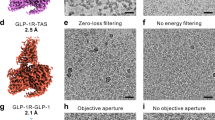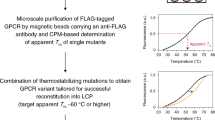Abstract
Cryogenic electron microscopy (cryo-EM) has widened the field of structure-based drug discovery by allowing for routine determination of membrane protein structures previously intractable. Despite representing one of the largest classes of therapeutic targets, most inactive-state G protein-coupled receptors (GPCRs) have remained inaccessible for cryo-EM because their small size and membrane-embedded nature impedes projection alignment for high-resolution map reconstructions. Here we demonstrate that the same single-chain camelid antibody (nanobody) recognizing a grafted intracellular loop can be used to obtain cryo-EM structures of inactive-state GPCRs at resolutions comparable or better than those obtained by X-ray crystallography. Using this approach, we obtained structures of neurotensin 1 receptor bound to antagonist SR48692, μ-opioid receptor bound to alvimopan, apo somatostatin receptor 2 and histamine receptor 2 bound to famotidine. We expect this rapid, straightforward approach to facilitate the broad exploration of GPCR inactive states without the need for extensive engineering and crystallization.
This is a preview of subscription content, access via your institution
Access options
Access Nature and 54 other Nature Portfolio journals
Get Nature+, our best-value online-access subscription
$29.99 / 30 days
cancel any time
Subscribe to this journal
Receive 12 print issues and online access
$189.00 per year
only $15.75 per issue
Buy this article
- Purchase on Springer Link
- Instant access to full article PDF
Prices may be subject to local taxes which are calculated during checkout





Similar content being viewed by others
Data availability
All data generated or analyzed in this study are included in this article, the supplementary information, or the source data files. The cryo-EM density maps and corresponding coordinates have been deposited in the Electron Microscopy Data Bank (EMDB) and the Protein Data Bank (PDB), respectively, under the following accession codes: NTSR1 (EMD-26589, PDB 7UL2), H2R (EMD-26590, PDB 7UL3), MOR (EMD-26591, PDB 7UL4) and SSTR2 (EMD-26592, PDB 7UL5). Raw data have been deposited in EMPIAR under the following accession codes: NTSR1 (EMPIAR-11136), MOR (EMPIAR-11135), SSTR2 (EMPIAR-11134) and H2R (EMPIAR-11137). Source data for raw images of cropped gels and data plotted in graphs are provided with this paper.
References
Robertson, M. J., Meyerowitz, J. G. & Skiniotis, G. Drug discovery in the era of cryo-electron microscopy. Trends Biochem. Sci. 47, 124–135 (2021).
Hauser, A. S., Attwood, M. M., Rask-Andersen, M., Schiöth, H. B. & Gloriam, D. E. Trends in GPCR drug discovery: new agents, targets and indications. Nat. Rev. Drug Discov. 16, 829–842 (2017).
Koehl, A. et al. Structure of the μ-opioid receptor-Gi protein complex. Nature 558, 547–552 (2018).
Tsutsumi, N. et al. Structure of a human Frizzled5 by fiducial-assisted cryo-EM supports a heterodimeric mechanism of canonical Wnt signaling. eLife 9, e58464 (2020).
Che, T. et al. Nanobody-enabled monitoring of kappa opioid receptor states. Nat. Commun. 11, 1145 (2020).
Gully, D. et al. Biochemical and pharmacological profile of a potent and selective nonpeptide antagonist of the neurotensin receptor. Proc. Natl Acad. Sci. USA 90, 65–69 (1993).
Uchański, T. et al. Megabodies expand the nanobody toolkit for protein structure determination by single-particle cryo-EM. Nat. Methods 18, 60–68 (2021).
Zimmerman, D. M. et al. Discovery of a potent, peripherally selective trans-3,4-dimethyl-4-(3-hydroxyphenyl)piperidine opioid antagonist for the treatment of gastrointestinal motility disorders. J. Med. Chem. 37, 2262–2265 (1994).
Bloch, J. et al. Development of a universal nanobody-binding Fab module for fiducial-assisted cryo-EM strudies of membrane proteins. Proc. Natl Acad. Sci. USA 118, e2115435118 (2021).
Carraway, R. & Leeman, S. E. Characterization of radioimmunoassayable neurotensin in the rat. Its differential distribution in the central nervous system, small intestine, and stomach. J. Biol. Chem. 251, 7045–7052 (1976).
Christou, N. et al. Neurotensin pathway in digestive cancers and clinical applications: an overview. Cell Death Dis. 11, 1027 (2020).
Liu, J. et al. Neurotensin receptor 1 antagonist SR48692 improves response to carboplatin by enhancing apoptosis and inhibiting drug efflux in ovarian cancer. Clin. Cancer Res. 23, 6516–6528 (2017).
Volkow, N. D. & Blanco, C. The changing opioid crisis: development, challenges and opportunities. Mol. Psychiatry 26, 218–233 (2021).
Volkow, N. D. & Collins, F. S. The role of science in addressing the opioid crisis. N. Engl. J. Med. 377, 391–394 (2017).
Günther, T. et al. International union of basic and clinical pharmacology. CV. somatostatin receptors: structure, function, ligands, and new nomenclature. Pharmacol. Rev. 70, 763–835 (2018).
Ballesteros, J. A. & Weinstein, H. Integrated methods for the construction of three-dimensional models and computational probing of structure-function relations in G protein-coupled receptors. Methods Neurosci. 25, 366–428 (1995).
Stoeber, M. et al. A genetically encoded biosensor reveals location bias of opioid drug action. Neuron 98, 963–976.e5 (2018).
Deluigi, M. et al. Complexes of the neurotensin receptor 1 with small-molecule ligands reveal structural determinants of full, partial, and inverse agonism. Sci. Adv. 7, eabe5504 (2021).
Mittl, P. R., Ernst, P. & Plückthun, A. Chaperone-assisted structure elucidation with DARPins. Curr. Opin. Struct. Biol. 60, 93–100 (2020).
Scott, D. J., Kummer, L., Egloff, P., Bathgate, R. A. D. & Plückthun, A. Improving the apo-state detergent stability of NTS1 with CHESS for pharmacological and structural studies. Biochim. Biophys. Acta 1838, 2817–2824 (2014).
Kato, H. E. et al. Conformational transitions of a neurotensin receptor 1–Gi1 complex. Nature 572, 80–85 (2019).
Kling, R. C. et al. Development of covalent ligand-receptor pairs to study the binding properties of nonpeptidic neurotensin receptor 1 antagonists. ACS Chem. Biol. 11, 869–875 (2016).
Russo, C. J. & Passmore, L. A. Ultrastable gold substrates for electron cryomicroscopy. Science 346, 1377–1380 (2014).
Punjani, A., Rubinstein, J. L., Fleet, D. J. & Brubaker, M. A. CryoSPARC: algorithms for rapid unsupervised cryo-EM structure determination. Nat. Methods 4, 290–296 (2017).
Wu, H. et al. Structure of the human κ-opioid receptor in complex with JDTic. Nature 485, 327–332 (2012).
Van Bever, W. F. M., Niemegeers, C. J., Schellekens, K. H. & Janssen, P. A. N-4 substituted 1-(2-arylethyl)-4 piperidinyl-N-phenylpropanamides, a novel series of extremely potent analgesics with unusually high safety margin. Arzneimittelforschung 26, 1548–1551 (1976).
Robertson, M. J., Meyerowitz, J. M., Panova, O., Borrelli, K. W. & Skiniotis, G. Plasticity in ligand recognition at somatostatin receptors. Nat. Struct. Mol. Biol. 29, 210–217 (2022).
Tunyasuvunakool, K. et al. Highly accurate protein structure prediction for the human proteome. Nature 596, 590–596 (2021).
Baek, M. et al. Accurate prediction of protein structures and interactions using a three-track neural network. Science 373, 871–876 (2021).
Kong, H., Raynor, K., Yasuda, K., Bell, G. I. & Reisine, T. Mutation of an aspartate at residue 89 in somatostatin receptor subtype 2 prevents Na+ regulation of agonist binding but does not alter receptor-G protein association. Mol. Pharmacol. 44, 380–384 (1993).
Martin, S., Botto, J. M., Vincent, J. P. & Mazella, J. Pivotal role of an aspartate residue in sodium sensitivity and coupling to G proteins of neurotensin receptors. Mol. Pharmacol. 55, 210–215 (1999).
Yabaluri, N. & Medzihradsky, F. Regulation of μ-opioid receptor in neural cells by extracellular sodium. J. Neurochem. 68, 1053–1061 (1997).
Fenalti, G. Molecular control of delta-opioid receptor signalling. Nature 506, 191–196 (2014).
Ereño-Orbea, J. et al. Structural basis of enhanced crystallizability induced by a molecular chaperone for antibody antigen-binding fragments. J. Mol. Biol. 430, 322–336 (2018).
Xu, P. et al. Structural insights into the lipid and ligand regulation of serotonin receptors. Nature 592, 469–473 (2021).
Shimamura, I. et al. Structure of the human histamine H1 receptor complex with doxepin. Nature 475, 65–70 (2011).
Marosi, A. et al. Solution-state NMR spectroscopy of famotidine revisited: spectral assignment, protonation sites, and their structural consequences. Anal. Bioanal. Chem. 402, 1653–1666 (2021).
Gantz, I. et al. Molecular basis for the interaction of histamine with the histamine H2 receptor. J. Biol. Chem. 267, 20840–20843 (1992).
Zivanov, J. et al. RELION-3: New tools for automated high-resolution cryo-EM structure determination. Elife 7, e42166 (2018).
Zheng, S. Q. et al. MotionCor2: anisotropic correction of beam-induced motion for improved cryo-electron microscopy. Nat. Methods 14, 331–332 (2017).
Rohou, A. & Grigorieff, N. CTFFIND4: fast and accurate defocus estimation from electron micrographs. J. Struct. Biol. 192, 216–221 (2015).
Pettersen, E. F. et al. UCSF ChimeraX: structure visualization for researchers, educators, and developers. Protein Sci. 30, 70–82 (2021).
Manglik, A. et al. Crystal structure of the μ-opioid receptor bound to a morphinan antagonist. Nature 485, 321–326 (2012).
Emsley, P., Lohkamp, B., Scott, W. G. & Cowtan, K. Features and development of Coot. Acta Crystallogr. D Biol. Crystallogr. 66, 486–501 (2010).
Adams, P. D. et al. PHENIX: a comprehensive Python-based system for macromolecular structure solution. Acta Crystallogr. D Biol. Crystallogr. 66, 213–221 (2010).
Robertson, M. J., van Zundert, G. C. P., Borrelli, K. & Skiniotis, G. GemSpot: a pipeline for robust modeling of ligands into cryo-EM maps. Structure 28, 707–716.e3 (2020).
Terwilliger, T. C., Ludtke, S. J., Read, R. J., Adams, P. D. & Afonine, P. V. Improvement of cryo-EM maps by density modification. Nat. Methods 17, 923–927 (2020).
Lomize, M. A., Pogozheva, I. D., Joo, H., Mosberg, H. I. & Lomize, A. L. OPM database and PPM web server: resources for positioning of proteins in membranes. Nucleic Acids Res. 40, D370–D376 (2012).
Lee, J. et al. CHARMM-GUI input generator for NAMD, GROMACS, AMBER, OpenMM, and CHARMM/OpenMM simulations using the CHARMM36 additive force field. J. Chem. Theory Comput. 12, 405–413 (2016).
Jorgensen, W. L., Chandrasekhar, J., Madura, J. D., Impey, R. W. & Klein, M. L. Comparison of simple potential functions for simulating liquid water. J. Chem. Phys. 79, 926–935 (1983).
Robertson, M. J., Tirado-Rives, J. & Jorgensen, W. L. Improved peptide and protein torsional energetics with the OPLS-AA force field. J. Chem. Theory Comput. 11, 3499–3509 (2015).
Robertson, M. J. & Skiniotis, G. Development of OPLS-AA/M parameters for simulations of G-protein coupled receptors and other membrane proteins. J. Chem. Theory Comput. 18, 4482–4489 (2022).
Humphrey, W., Dalke, A. & Schulten, K. VMD: visual molecular dynamics. J. Mol. Graph. 14, 33–38 (1996).
Jacobson, M. P. et al. A hierarchical approach to all-atom protein loop prediction. Proteins Struct. Funct. Bioinformatics 55, 351–367 (2004).
Phillips, J. C. et al. Scalable molecular dynamics with NAMD. J. Comput. Chem. 26, 1781–1802 (2005).
Ryckaert, J. P., Ciccotti, G. & Berendsen, H. J. C. Numerical integration of the cartesian equations of motion of a system with constraints: molecular dynamics of n-alkanes. J. Comput. Phys. 23, 327–341 (1977).
Miyamoto, S. & Kollman, P. A. Settle: an analytical version of the SHAKE and RATTLE algorithm for rigid water models. J. Comput. Chem. 13, 952–962 (1992).
Friesner, R. A. et al. Extra precision glide: docking and scoring incorporating a model of hydrophobic enclosure for protein-ligand complexes. J. Med. Chem. 49, 6177–6196 (2006).
Towns, J. et al. XSEDE: Accelerating scientific discovery. Comput. Sci. Eng. 16, 62–74 (2014).
Acknowledgements
We thank the Kobilka lab (Stanford) for providing plasmids of NTSR1 and MOR. We thank the Kossiakoff lab (University of Chicago) for providing the plasmid for NabFab and constructive feedback. Cryo-EM data were collected at the Stanford cryo-EM center (cEMc) with support from E. Montabana. This work was supported, in part, by the Mathers Foundation (to G.S., and training grant No. T32GM089626 to J.G.M.), the National Institutes of Health (grant No. R35GM143061 to T.C.) and used the Extreme Science and Engineering Discovery Environment (XSEDE)59 resource comet-gpu through sdsc-comet allocation (grant No. TG-MCB190153 to G.S.), which is supported by National Science Foundation (grant No. ACI-1548562).
Author information
Authors and Affiliations
Contributions
M.J.R. cloned constructs, expressed and purified proteins, processed EM data, built models and ran/analyzed molecular dynamics simulations. M.M.P.-S. expressed and purified proteins and collected cryo-EM data. F.H. cloned constructs and expressed proteins. J.G.M. performed BRET assays. A.B.S. prepared cryo-EM samples and collected cryo-EM data. M.C.P. expressed proteins and purified the nanobody. O.P. prepared cryo-EM samples and collected cryo-EM data. T.C. provided constructs for nanobody expression and BRET assays. M.J.R. and G.S. wrote the manuscript with input from M.M.P.-S., F.H., J.G.M., O.P. and T.C. G.S. supervised the project.
Corresponding author
Ethics declarations
Competing interests
The authors declare no competing interests.
Peer review
Peer review information
Nature Structural and Molecular Biology thanks Ali Jazayeri and the other, anonymous, reviewer(s) for their contribution to the peer review of this work. Primary Handling Editors: Carolina Perdigoto and Florian Ullrich, in collaboration with the Nature Structural and Molecular Biology team.
Additional information
Publisher’s note Springer Nature remains neutral with regard to jurisdictional claims in published maps and institutional affiliations.
Extended data
Extended Data Fig. 1 Biochemical characterization of receptor Nb6/Mb6 complexes.
(A) Size exclusion chromatography (SEC) profile of hNTSR1/Nb6 complex; bracket indicates fractions harvested for cryoEM. (B) SDS-PAGE gel of hNTSR1/Nb6 complex. (C) SEC profile of MOR/Mb6 complex; bracket indicates fractions harvested for cryoEM. (D) SDS-PAGE gel of MOR/Mb6 complex. (E) SEC profile of SSTR2/Nb6 complex; bracket indicates fractions harvested for cryoEM. (F) SDS-PAGE gel of SSTR2/Nb6 complex. (G) SEC profile of H2R/Nb6M/NabFab/Anti-Fab Nb (H) SDS-PAGE gel of H2R/Nb6M/NabFab/Anti-Fab Nb. All gels are from a single experiment, uncropped versions are provided as source data.
Extended Data Fig. 2 hNTSR1/Nb6 cryo-EM data collection and processing.
(A) Representative micrograph of hNTSR1/Nb6 complex, one micrograph of 5,818. (B) Example final 2D classes of hNTSR1/Nb6 complex. (C) Cryo-EM data processing workflow. (D) Local resolution of hNTSR1/Nb6 global refinement with FSC curve below. (E) Local resolution of hNTSR1/Nb6 local refinement with FSC curve below.
Extended Data Fig. 3 Comparison between hNTSR1/Nb6 cryoEM structure and rNTSR1H4/DARPin crystal structure.
(A) 2Fo-Fc crystallography map at 2.7 Å of rNTSR-H4bmx contoured at 𝜎=1.0. (B) 2Fo-Fc crystallography map at 2.7 Å of rNTSR-H4bmx bound SR antagonist contoured at 𝜎=1.0. (C) Structure of hNTSR1 (green) in the extracellular ligand binding pocket showing water molecules and corresponding cryoEM map features. (D) Overlay of hNTSR1 (green) and rNTSR1H4 (gray) highlighting the movement of TM1 (E) Overlay of hNTSR1 (green) and rNTSR1H4 (gray) with the cryoEM map for hNTSR1 (green) for ECL1 (F) Overlay of hNTSR1 (green) and rNTSR1H4 (gray) with the rNTSR1H4 crystal structure 2Fo-Fc map contoured at 𝜎 = 1.0. (G) Overlay of hNTSR1 (green), rNTSR1H4 (gray), and MOR PDB 4DKL (blue) showing the position of NPXXY motif Y7.53.
Extended Data Fig. 4 MOR/Mb6 cryo-EM data collection and processing.
(A) Representative micrograph of MOR/Mb6 complex, one micrograph of 14,635. (B) Example final 2D classes of MOR/Mb6 complex. (C) Cryo-EM data processing workflow. (D) Local resolution of MOR/Mb6 global refinement with FSC curve below. (E) Local resolution of MOR/Mb6 local refinement with FSC curve below.
Extended Data Fig. 5 Inactive MOR bound to avlimopan.
(A) overlay of snapshots from Mb6 molecular dynamics simulations aligned on the nanobody portion. (B) Comparison of Inactive MOR (dark blue) bound to alvimopan (magenta) and bound water in density modified map (grey) (C) Comparison of Inactive MOR (dark blue) bound to alvimopan (magenta) and carfentanyl (yellow) docked into the active state MOR receptor (light blue).
Extended Data Fig. 6 SSTR2/Nb6 cryo-EM data collection and processing.
(A) Representative micrograph of SSTR2/Nb6 complex, one micrograph of 6,846. (B) Example final 2D classes of SSTR2/Nb6 complex. (C) Cryo-EM data processing workflow. (D) Local resolution of SSTR2/Nb6 global refinement with FSC curve below.
Extended Data Fig. 7 Comparison of CryoEM Maps and Putative Ion Sites.
(A) Sodium ion site of hNTSR1 with cryoEM map. (B) Probable sodium ion site of MOR with cryoEM map. (C) Probable sodium ion site of SSTR2 with cryoEM map. (D) Sodium ion site of DOR (PDB 4N6H) with 2Fo-Fc map contoured at 𝜎 = 2.0 (E) Overlay of NTSR1 (green) cryoEM structures sodium ion binding site with the DOR sodium coordination site structure (gray, PDB 4N6H).
Extended Data Fig. 8 Inactive H2R/Nb6M/NabFab/Anti-Fab Nb cryoEM data collection and processing.
(A), Representative micrograph of H2R complex, one micrograph of 7,728. (B), Example final 2D classes of H2R complex. (C), CryoEM data processing workflow. (D), Local resolution of H2R global refinement (E), Local resolution of H2R local refinement (F), FSC curve of H2R global refinement (G) FSC curve of H2R local refinement.
Extended Data Fig. 9 Inactive H2R Structure and Comparison to H1R.
(A) Cryo-EM map of H2R with lipid density between TM1 and TM7 colored in orange. (B-D) Chemical structures of doxepin (B), loratadine (C), and cetirizine (D) with protonated amine highlighted and crystal structure of H1R (magenta) bound to doxepin (teal) (PDB 3RZE) loratadine (teal, docked pose) and cetirizine (teal, docked pose). (E-G) Chemical structures of famotidine (E), ranitidine (F), and cimetidine (G) with protonated amines highlighted in dashed (high pKa) and dotted (low pKa) boxes, together with cryoEM structure of H2R (lavender) bound to famotidine (goldenrod, this work), ranitidine (goldenrod, docked pose) and cimetidine (goldenrod, docked pose).
Extended Data Fig. 10 Map-Model Agreements.
(A) Map-model comparison for NTSR1. (B) Map-model comparison for MOR. (C) Map-Model comparison for SSTR2. (D) Map-Model comparison for H2R.
Supplementary information
Source data
Source Data Fig. 1
Data for graph plots in Fig. 1.
Source Data Extended Data Fig. 1
Raw uncropped gels.
Rights and permissions
Springer Nature or its licensor (e.g. a society or other partner) holds exclusive rights to this article under a publishing agreement with the author(s) or other rightsholder(s); author self-archiving of the accepted manuscript version of this article is solely governed by the terms of such publishing agreement and applicable law.
About this article
Cite this article
Robertson, M.J., Papasergi-Scott, M.M., He, F. et al. Structure determination of inactive-state GPCRs with a universal nanobody. Nat Struct Mol Biol 29, 1188–1195 (2022). https://doi.org/10.1038/s41594-022-00859-8
Received:
Accepted:
Published:
Issue Date:
DOI: https://doi.org/10.1038/s41594-022-00859-8
This article is cited by
-
Cryo-EM structure of cell-free synthesized human histamine 2 receptor/Gs complex in nanodisc environment
Nature Communications (2024)
-
A method for structure determination of GPCRs in various states
Nature Chemical Biology (2024)
-
Capturing receptor states with glue
Nature Chemical Biology (2024)
-
A framework for Frizzled-G protein coupling and implications to the PCP signaling pathways
Cell Discovery (2024)
-
Structural insights into the activation and inhibition of CXC chemokine receptor 3
Nature Structural & Molecular Biology (2024)



